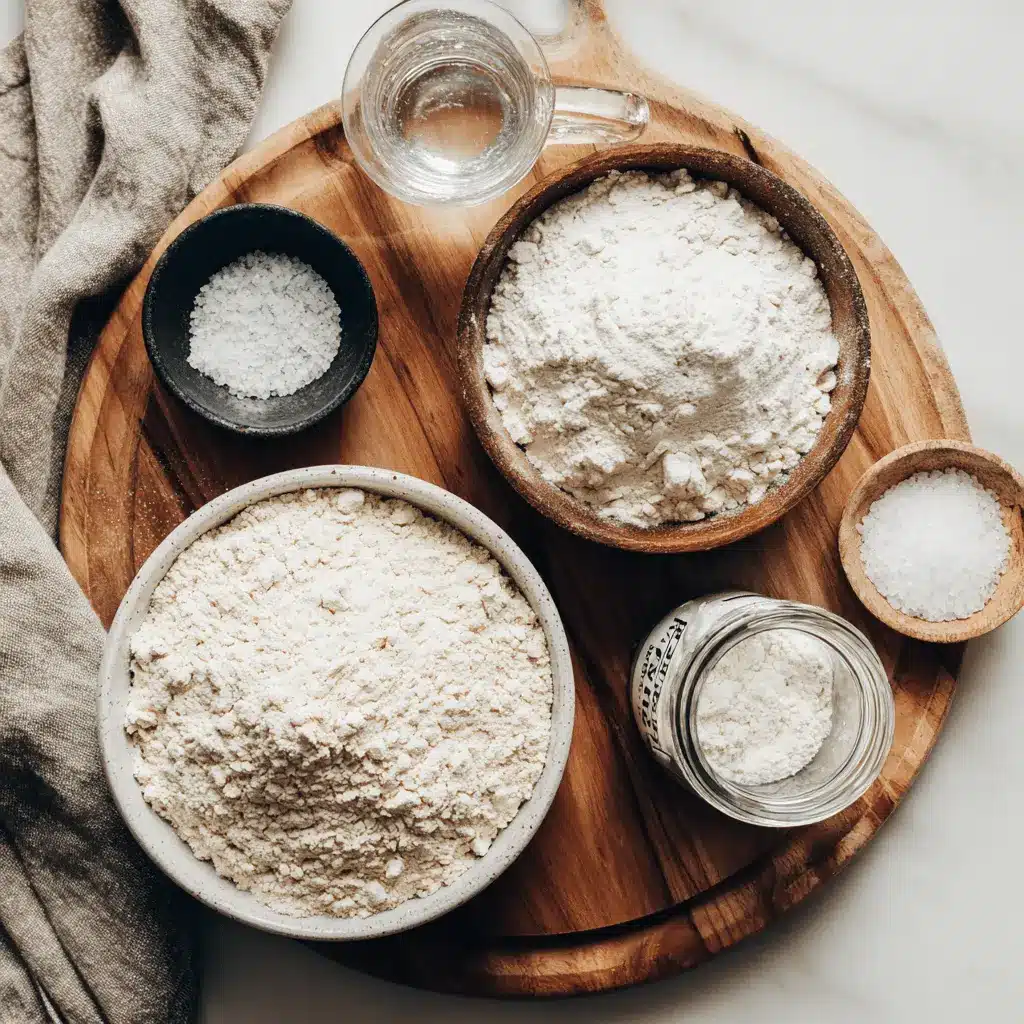Ever notice how the smell of golden crust and tangy warmth instantly brings you back? This Dutch Oven Sourdough Bread recipe smells exactly like Saturday mornings at Grandma’s. It’s cozy, a little rustic, and blowing up all over Pinterest for that perfect crunchy finish. Beginner-friendly, no fuss. Just time, love, and a crispy pay-off.
It’s a warm-hearted, homemade loaf with a chewy crumb and shattery crust. Just flour, salt, and a little kitchen magic—stuff you likely already have. Think your mom’s white bread, but cooler and with a serious crunch. Full details in the blog!
I first baked this with my grandma, standing tiptoe to reach the flour bin in her tiny Texas kitchen. Years (and culinary school) later, I still use her no-frills method. No gadgets here. Just a hot pot and one pro tip I promise you’ll love.
Why You’ll Love This Recipe
This Dutch Oven Sourdough Bread recipe is pure magic—transforming simple pantry staples into a bakery-quality loaf right in your own kitchen. That crackly, caramelized crust paired with the soft, chewy crumb is what dreams are made of. It’s rustic, nostalgic, and feels like a hug in bread form.
The process is beginner-friendly while giving you that pro-level crunch that rivals any artisan boule. Plus, the Dutch oven does most of the work, locking in steam for a truly stunning crust. It’s cozy, it’s practical, and it’ll make your house smell better than any candle ever could!
Key Ingredients and Tools

Would you believe that this rustic beauty comes from just four ingredients? Organic bread flour gives the loaf structure, while the bubbly sourdough starter provides flavor and rise. A pinch of sea salt enhances the flavor, and plain water ties everything together like a kitchen symphony. That’s it—no fancy gadgets, just pure simplicity.
The real game-changer here is the Dutch oven. Its heavy lid traps steam, creating that gorgeous golden crust. A kitchen scale is also key for precise measurements—don’t guess, trust me. And if you don’t have a proofing basket, a towel-lined bowl sprinkled with flour works just fine. Cozy, resourceful, and doable!
Step-by-Step Process
Pro Tip: Time and patience are your best friends here. Start early, give the dough love, and let it do its thing. From feeding your starter to those therapeutic stretching and folding sessions, every step builds texture and flavor. Follow the stretches, folds, and resting periods in the recipe for foolproof sourdough magic.
When shaping, don’t stress about perfection—a slightly messy fold adds character. Finally, bake the dough in a preheated Dutch oven. The first 30 minutes under the lid give it that iconic rise and crust. For the last 20-30 minutes, remove the lid to let the crust deepen in color. It may be tempting, but let your loaf cool completely—it’s still finishing its magic inside.
Troubleshooting and Best Practices
Sticky dough got you down? Lightly flour your hands and countertop. If your dough is too slack, let it rest longer during folding to build strength. For over-proofed dough, shape it gently and bake—it might not rise as tall, but it’ll still taste heavenly.
Wondering if it’s baked through? Tap the bottom of the loaf—it should sound hollow. If you’re unsure, an extra 5 minutes in the oven (uncovered) won’t hurt. And pay attention to those stretches—underdoing them will leave the dough dense, while over-proofing makes it too loose to handle.
Serving, Storage, and Variations
This bread is at its prime fresh from the oven. Slather it with butter or pair it with a steamy bowl of soup for peak coziness. To keep your Dutch Oven Sourdough Bread crusty, store it in a paper bag or wrap it in a clean dish towel—skip the plastic, which softens the crust.
Looking to mix things up? Add seeds like sesame or sunflower to the crust for extra crunch. A pinch of dried herbs like rosemary or thyme folded into the dough takes it from classic to gourmet in seconds. Whether it’s sandwiches, toast, or tear-and-share dinners, this bread adapts beautifully.
| Timing Guide | Step | Duration |
|---|---|---|
| Morning | Mix dough and start stretches | 3 hours (with rests) |
| Afternoon | Final shaping | 1 hour |
| Overnight | Cold proof in fridge | 8-12 hours |
| Next Day | Preheat, bake, and cool | ~2 hours |
Expert Insight: Perfecting Dutch Oven Sourdough Bread
The Dutch Oven Sourdough Bread technique leverages steam and even heat distribution to create a crisp crust and tender crumb. Using a covered pot replicates a professional steam oven, which is key to achieving bakery-quality results at home. Patience in fermentation and baking ensures depth of flavor and texture.
For more delicious recipes and cooking inspiration, follow me on Facebook, Pinterest and Reddit!
A Fond Sourdough Memory
Every time I bake this Dutch Oven Sourdough Bread Recipe, I’m reminded of afternoons baking alongside my grandmother in her cozy kitchen. The slow rise, the fragrant crust—it’s not just bread, it’s a comforting ritual that brings family together, perfect for busy days when wholesome, homemade really matters.
FAQs ( Dutch Oven Sourdough Bread Recipe (Master Recipe) )
How do I activate my sourdough starter for this recipe?
To activate your sourdough starter, feed it with equal parts flour and water about 4 to 12 hours before you begin baking, depending on its room temperature activity. It should be bubbly, doubled in size, and have a pleasant tangy aroma when ready. Using an active starter ensures your Dutch Oven Sourdough Bread rises beautifully and develops that signature flavor.
Can I use all-purpose flour instead of bread flour?
Yes, you can use all-purpose flour if bread flour isn’t available, but expect a slightly less chewy crust and a softer crumb. Bread flour’s higher protein content helps create better gluten development, which leads to more structure in your Dutch Oven Sourdough Bread. Mixing all-purpose with some whole wheat can also add flavor and texture.
How do I prevent my sourdough bread from getting too hard?
To keep your Dutch Oven Sourdough Bread from getting too hard, avoid overbaking and let it cool completely on a wire rack to retain moisture without becoming soggy. Additionally, store the bread in a paper bag or bread box rather than plastic to allow some airflow. Proper hydration in your dough and gentle handling also contribute to a tender crumb.
What is the best way to store Dutch Oven Sourdough Bread?
The best way to store your Dutch Oven Sourdough Bread is at room temperature wrapped loosely in a clean kitchen towel or stored in a paper bag to keep the crust crisp and the inside moist. Avoid plastic bags unless freezing, which is ideal if you want to keep your bread for more than a few days. Slice as needed for maximum freshness.
Can I freeze Dutch Oven Sourdough Bread?
Absolutely! Freezing Dutch Oven Sourdough Bread works great for preserving freshness. Slice the bread beforehand and wrap it tightly in plastic wrap or foil, then place it in a freezer-safe bag. When ready to enjoy, thaw at room temperature or toast slices directly from frozen for a crusty, delicious treat.
Bringing It All Together
This Dutch Oven Sourdough Bread bakes up crispy and rustic, with a soft crumb that feels like a warm kitchen hug. It’s surprisingly simple for such a stunning loaf—just a few hours of gentle folding and waiting, then pure magic. You’ll love how it turns your pantry basics into a homemade treasure that tastes like tradition.
For a little twist, try folding in herbs or seeds before the final rise—your kitchen will smell amazing. To keep that crust perfect, wrap your loaf in a clean towel or a paper bag. Here’s a little pro tip I’ve picked up: letting it cool completely before slicing really lets the flavors settle, trust me on that one.
Did this recipe bring back any family baking memories? I’d love to see your photos or hear how you made it your own. Share the love by passing it along, because good bread—and good stories—are meant to be shared. Happy baking, friends!

Dutch Oven Sourdough Bread Recipe for Perfect Crispy Crust
Ingredients
Method
- Start the sourdough process before 9 am to allow enough time. In a large bowl, combine sourdough starter, bread flour, sea salt, and water. Knead the ingredients together until a uniform dough ball forms. Mist your clean countertop with water, wet your hands and the top of the dough, then turn the dough onto the wet surface. Scrape and rinse the bowl well, leaving it wet. Stretch and fold the dough by pulling the top over the bottom, sides over each other, and place seam side down in the bowl. Let the dough rest for 30 minutes. Repeat the misting, stretching, folding, and resting process three more times, resting 2 hours between each stretch and fold. Clean and dry your countertop, sprinkle with flour and flour your hands. Flip the dough onto the floured surface seam side up. Pre-shape the dough by gently stretching and folding, then form a circular shape with the seam side down. Sprinkle flour on top, cover with a tea towel, and let rest for 1 hour. Sprinkle more flour, flip the dough seam side up, and perform the final shaping by stretching and folding. Flour a proofing basket or bowl lined with a towel and flour. Place the shaped dough seam side up into the basket. Cover and refrigerate overnight (8-12 hours). Preheat your oven and Dutch oven with lid at 450°F. Carefully remove the hot Dutch oven, place lid aside. Place a parchment paper square on the counter, turn dough seam side down onto parchment. Score the dough with a sharp knife or scoring tool. Lift the dough using parchment corners and place into the Dutch oven. Cover with lid and bake at 450°F for 30 minutes. Remove lid and bake uncovered for an additional 20-30 minutes until golden brown. Remove bread from Dutch oven and cool at least 1 hour before slicing.
Notes
Use a bread proofer or heating pad to speed up fermentation if needed.
Use coarse flour like rye or rice for dusting proofing baskets.
Oven temperatures vary; monitor browning during uncovered baking and adjust time accordingly.
Handle the hot Dutch oven carefully to avoid burns.









